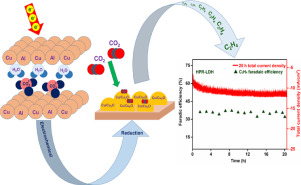Journal of Energy Chemistry ( IF 14.0 ) Pub Date : 2019-12-28 , DOI: 10.1016/j.jechem.2019.12.013 Naveed Altaf , Shuyu Liang , Liang Huang , Qiang Wang

|
Recently, CO2 conversion by electrochemical tool into value-added chemicals has been considered as one of the most promising strategies to offer sustainable development in energy and environment. In this contribution, we investigated electro-derived composites from Cu-based layered double hydroxide (LDH) for CO2 electrochemical reduction. The Cu-Cu2O based nanocomposite (HPR-LDH) were derived by using electro-strategy from LDH having the stability up to 20 h and selectivity toward C2H4 with faraday efficiency up to 36% by significantly suppressing CH4 and H2 with respect to bulk Cu foil. A highly negative reduction potential derived catalyst (HPR-LDH) maintained long-term stability for the selective production of ethylene over methane, and a small amount of Cu2O was still observed on the catalyst surface after CO2 reduction reaction (CO2RR). Moreover, such unique strategy for electro-derived composite from LDH having small nanoparticles stacked each other grown on layered structure, would provide new insight to improve durability of O Cu combination catalysts for C
Cu combination catalysts for C C coupling products during electrochemical CO2 conversion by suppressing HER. The XRD, SEM, ESR, and XPS analyses confirmed that the long-term ethylene selectivity of HPR-LDH is due to the presence of subsurface oxygen. The designed composite catalyst significantly enhances the stability and selectivity, and also decreases the over potential for CO2 electro-reduction. We predict that the new designed LDH 2D-derived composites may attract new insight for transition metal and may open up a new direction for known structural properties of selective catalyst synthesis regarding effective CO2 reduction reaction.
C coupling products during electrochemical CO2 conversion by suppressing HER. The XRD, SEM, ESR, and XPS analyses confirmed that the long-term ethylene selectivity of HPR-LDH is due to the presence of subsurface oxygen. The designed composite catalyst significantly enhances the stability and selectivity, and also decreases the over potential for CO2 electro-reduction. We predict that the new designed LDH 2D-derived composites may attract new insight for transition metal and may open up a new direction for known structural properties of selective catalyst synthesis regarding effective CO2 reduction reaction.
中文翻译:

LDH的电衍生Cu-Cu 2 O纳米簇,用于从CO 2电化学还原中稳定和选择性地生产C 2烃
近来,通过电化学工具将CO 2转化为增值化学品已被认为是在能源和环境中实现可持续发展的最有希望的战略之一。在这项贡献中,我们研究了基于铜的层状双氢氧化物(LDH)的电衍生复合材料,用于CO 2电化学还原。Cu-Cu 2 O基纳米复合材料(HPR-LDH)是通过使用LDH进行电沉积而获得的,通过显着抑制CH 4和H ,LDH具有高达20 h的稳定性和对C 2 H 4的选择性,法拉第效率高达36%2个关于块状铜箔。高负还原电位衍生催化剂(HPR-LDH)保持了乙烯在甲烷上选择性生产的长期稳定性,并且在CO 2还原反应后(CO 2 RR)在催化剂表面仍观察到少量的Cu 2 O )。而且,这种由LDH衍生的具有小纳米颗粒彼此堆叠在层状结构上的LDH电衍生复合材料的独特策略,将为改善电化学CO 2期间用于C C偶联产物的O Cu组合催化剂的耐久性提供新的见解。
 通过抑制HER进行转换。XRD,SEM,ESR和XPS分析证实HPR-LDH的长期乙烯选择性是由于存在地下氧的缘故。设计的复合催化剂显着提高了稳定性和选择性,还降低了CO 2电还原的过电势。我们预测,新设计的LDH 2D衍生的复合材料可能会吸引人们对过渡金属的新见解,并可能为选择性催化剂合成的有效CO 2还原反应的已知结构性质开辟新的方向。
通过抑制HER进行转换。XRD,SEM,ESR和XPS分析证实HPR-LDH的长期乙烯选择性是由于存在地下氧的缘故。设计的复合催化剂显着提高了稳定性和选择性,还降低了CO 2电还原的过电势。我们预测,新设计的LDH 2D衍生的复合材料可能会吸引人们对过渡金属的新见解,并可能为选择性催化剂合成的有效CO 2还原反应的已知结构性质开辟新的方向。











































 京公网安备 11010802027423号
京公网安备 11010802027423号